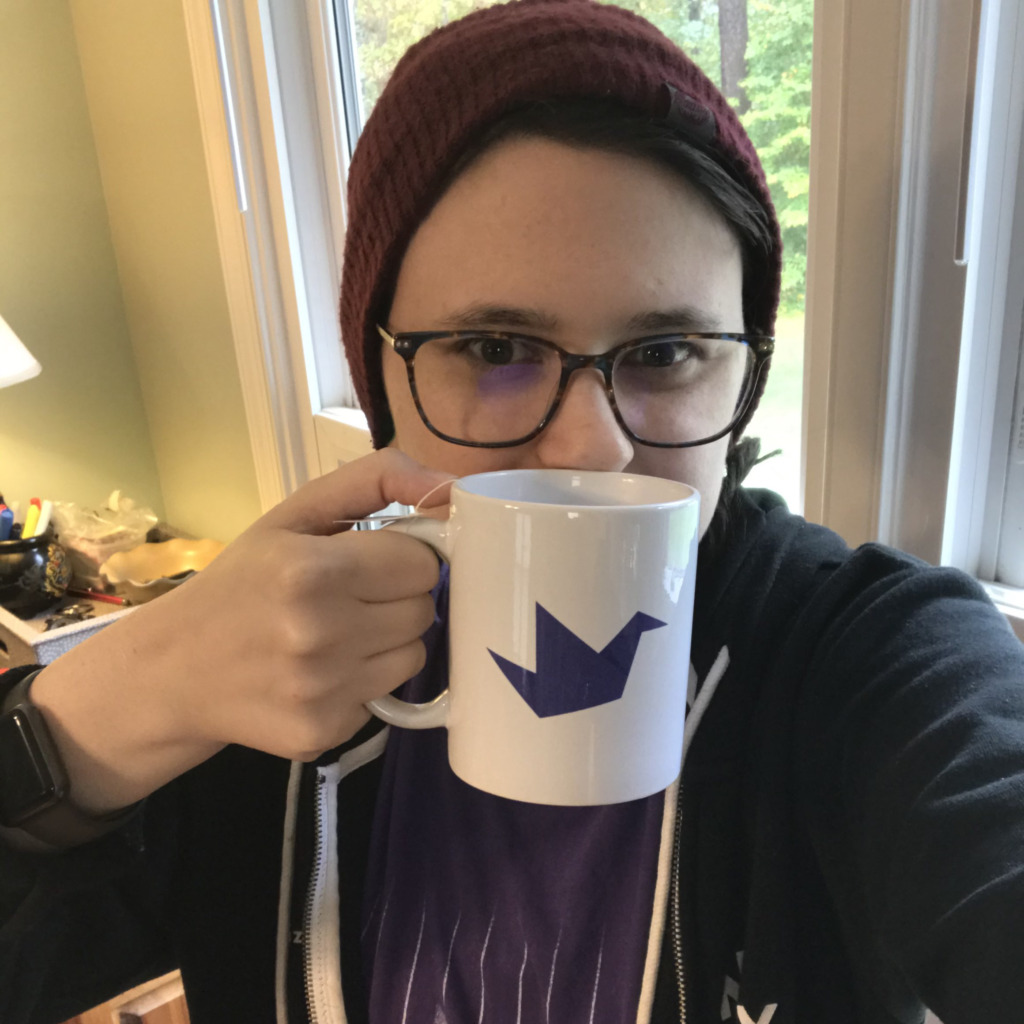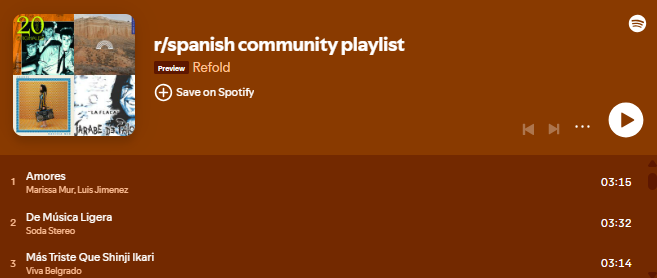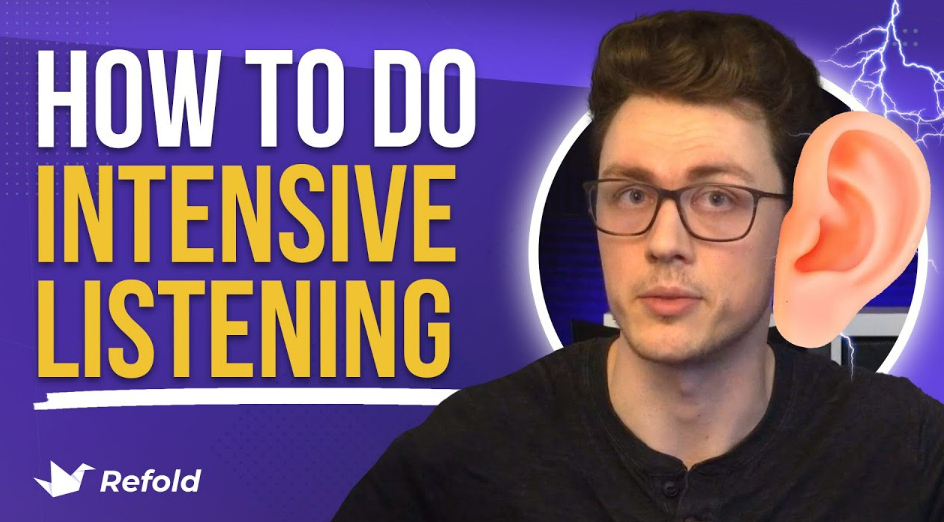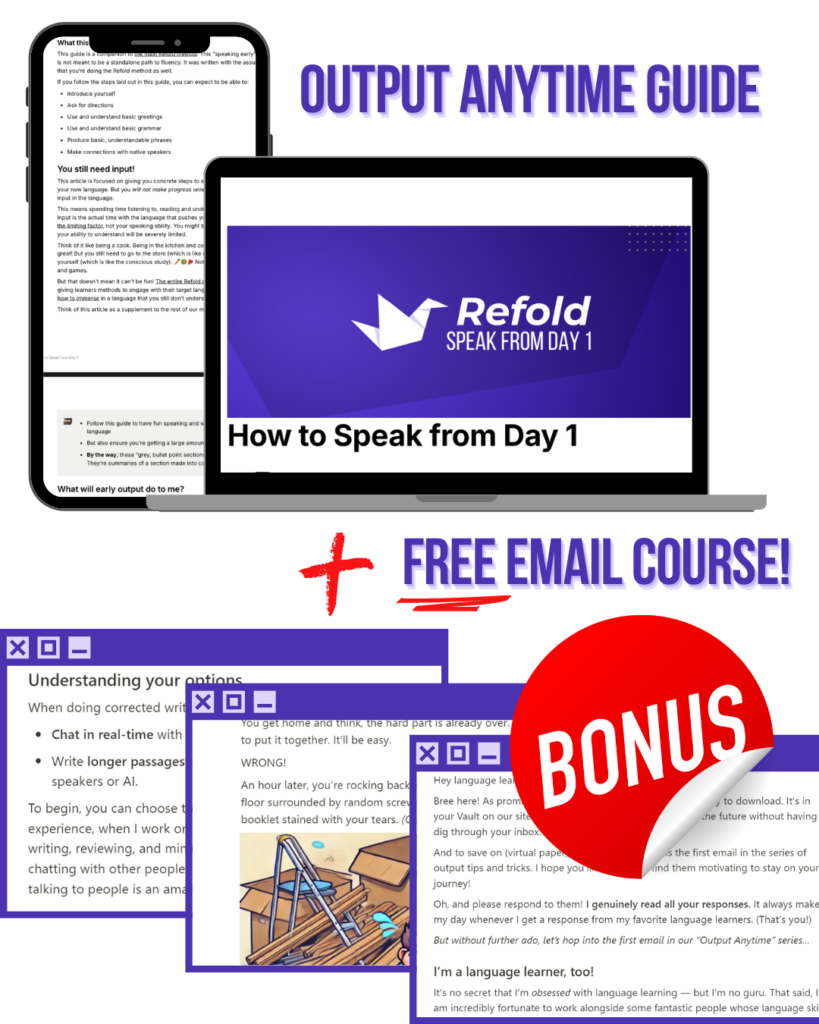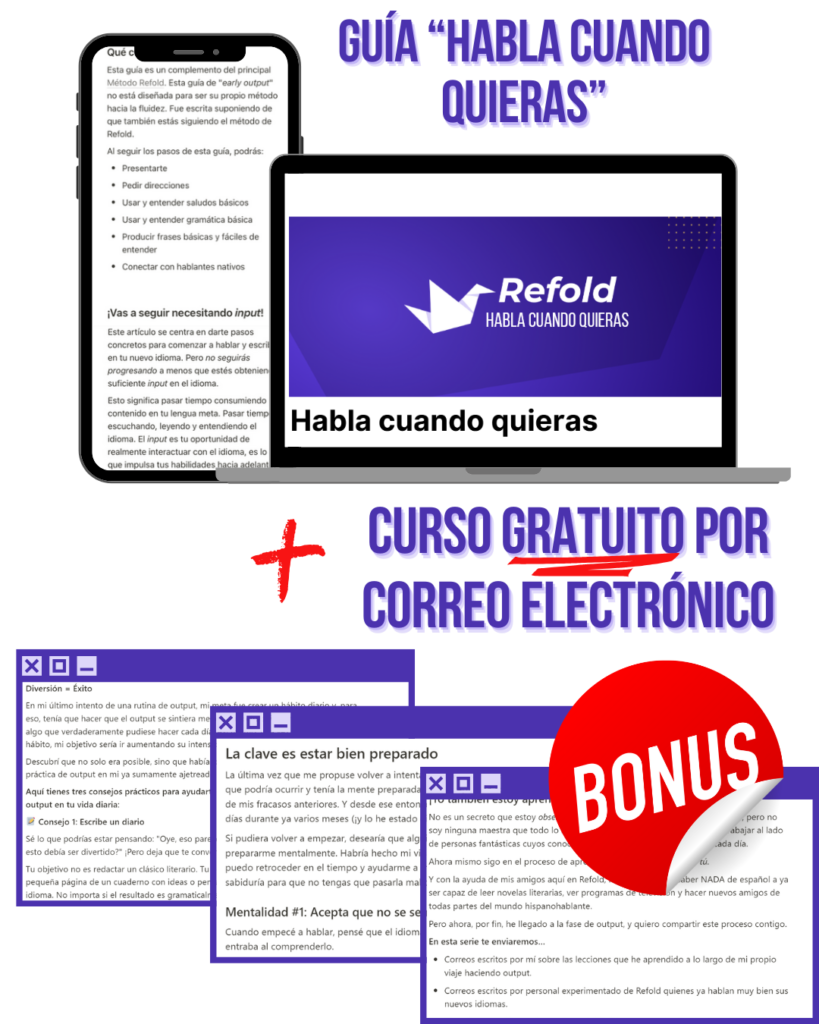Hey there, fellow language learners! If you’re reading this blog, it means that you want to learn how to learn a language on your own. Regardless if you’ve never learned a language before, you’re a seasoned language learner looking for new strategies, or you’ve tried and failed several times to learn a language in the past—you’re in the right place!
In this blog, we’ll explain how the Refold method for learning languages works and why it’s different from other traditional language methods.
The problem with Language Learning
Ever wondered how to actually learn a language? Nearly EVERYONE studies a second language as a teen or adult, but the number of people who fluently speak that language well is shockingly low.
How could that be possible?! Humans are wired to learn language. We’ve been doing it for 150,000 YEARS. It’s literally built into our DNA.
The reason? The language learning industry is broken. The success rate of language learners worldwide is abysmal, and most people fail to learn a language using traditional methods!
Traditional Language Learning is NOT the Best Way to Learn a Language
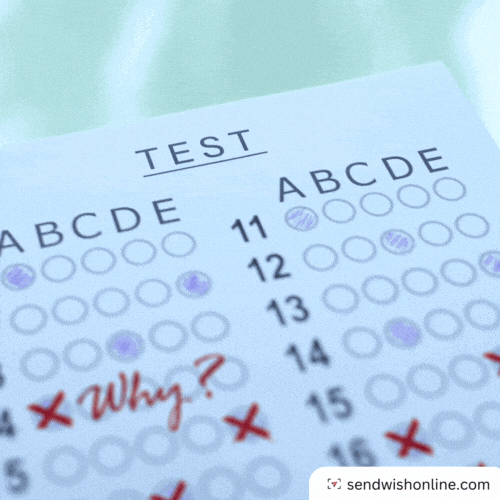
The traditional method of learning is what we call “grammar-translation.” Most people believe that this is the best way to learn a language, even though most people never achieve true fluency with this method.
Traditional learning methods teach you grammar as a way to translate between two languages.
They think that you can learn a language if you practice translation enough because it will eventually become automatic and instantaneous, and you’ll be fluent.
In reality, you just end up translating forever.
Upside: You can make blazing-fast progress for a few days or weeks and speak pretty quickly. But there is a hard limit to using speaking hacks and memorizing phrases.
Downside: Speaking like this creates unnatural language. Other languages aren’t just English but with different pronunciations and word order. It is difficult, or even impossible, for people to reach true fluency with the grammar-translation method.
What Does Fluency Mean?
When people dream of fluency, they imagine speaking a second language as naturally as their first, being able to navigate the language through feeling.
So, what does fluency mean if you think of it like this? It means you have a “language instinct,” and that’s what we focus on with the Refold method. We want you to use a language without conscious thought. Grammar-translation will never help you gain an instinct for the language.
Developing a language instinct takes a lot of time, even if you’re using the right methods! Another reason people fail is because they rely on motivation.
However, the truth is that…
Motivation is a Scam
Most people think motivation is the key to how to learn a new language by yourself, but learning a language is a long-term goal, and most people fail to recognize that. Many people get the wrong idea by watching polyglot YouTube or Duolingo marketing and think they can learn a language with a bit of focus and minor effort.
Most people end up relying on bursts of motivation for language learning, but these bursts of motivation don’t last long enough to get learners to fluency.

So, a large part of our method focuses on sustainable habits and processes to ensure you get to fluency, no matter what.
Like what you see?
Sign up now and we'll deliver even MORE amazing content like this right to your inbox!
- Receive our exclusive 6 SECRETS to language learning success email course.
- Stay motivated with weekly emails overflowing with helpful language-learning tips, tutorials, and more!
- Get behind the scenes access into the inner workings of Refold!
Get our 6 SECRETS to language learning success
How to Actually Learn a Language
Ok, now that we’ve covered many of the ways that traditional language learning will not work, we’re going to teach you what will! The Refold method is carefully designed to teach you how to actually learn a language and reach your fluency goals!
First, if you want to be successful, your goal should be to…
Building a Language Instinct
Humans are excellent at learning languages; if you think about it, everyone knows how to learn a language! Everyone speaks at least one, without even trying. We pick up the patterns of our native languages as children through observation and interaction. Our brains are pattern-matching MACHINES.
All we need is exposure to those patterns. Lots and lots of time and repetition leads to excellent pattern recognition, knowledge, and language fluency.
In order to achieve this instinct, you’ll need lots of something called “input.”
The Real Way to Learn a Language: Optimal Input
We learn languages by understanding messages in that language. Understanding the language is called “input” (which is reading/writing or a combination of both).
However, you can’t just barrage yourself with the language and hope to learn.
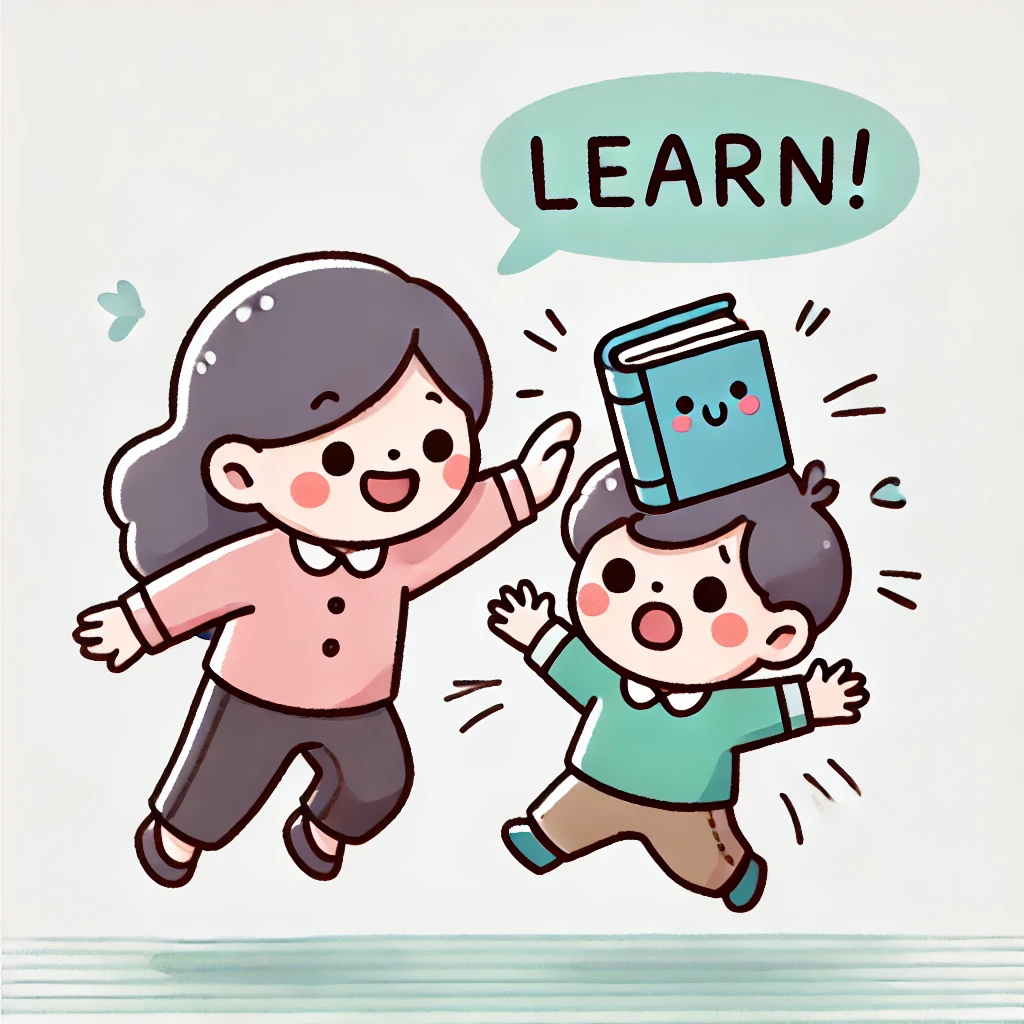
You need what we call “optimal input,” which has a few different parts to it.
Optimal input is:
- Interesting
- Comfortable
- Understandable
Let’s dive into each one of these aspects a bit further.
1. Interesting Immersion Content
You must care (at least a little) about the language and what is being said. If you’re totally uninterested in learning, it will be very difficult. No “language” is boring, but the content might be. This is why Refold focuses on helping learners have fun and find the content that suits them.
2. Comfortable Environment
You also need to be at ease when learning. If you’re stressed or physically uncomfortable (for whatever reason), you are less receptive, and it’ll be harder to learn. It’s important to be free from distractions, have good video/audio quality, and have a nice place to be to maximize your learning ability.
3. Understandable Content
And finally, input needs to be comprehensible. Not entirely. You only need to understand bits and pieces or individual words. Or even be able to guess what’s happening from actions and visuals.
But if you’re not understanding anything, you’re not learning anything.
Once you have your content set up, it’s important to manage your expectations and understand that…
Comprehension Grows with Practice
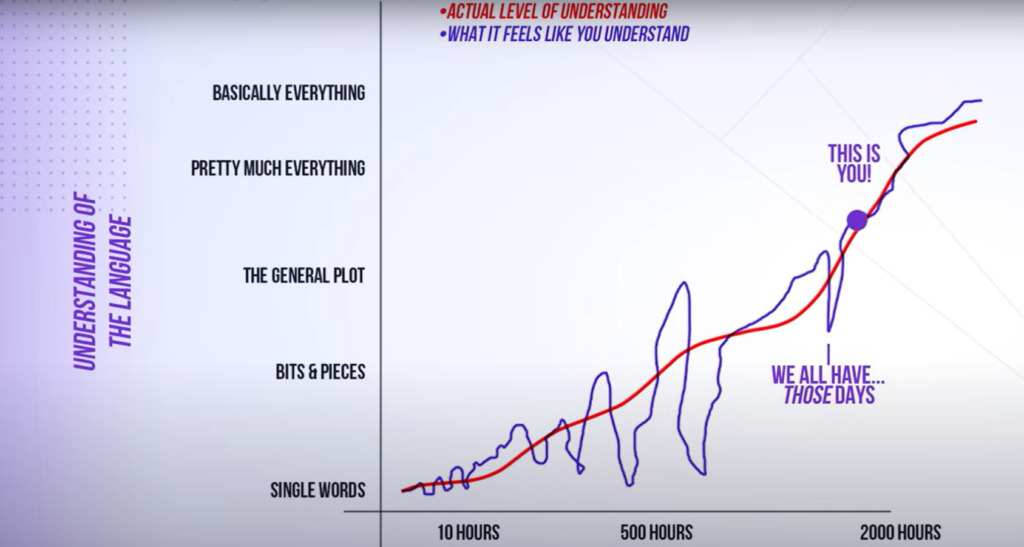
In the beginning, you’ll only understand bits and pieces. But don’t worry, if you’re understanding anything, even single words, your brain is in the background, learning the patterns of the language.
Eventually, your ability will improve to the point where you’re understanding whole sentences. The main idea, or plot, of what’s happening may still elude you.
Then, you’ll reach the point where you understand the main idea, but there will be lots of nuance that you’re still missing.
And then, at some point, you’ll be able to understand everything, even the nuance, like a native speaker would.
It’s easy to get discouraged when even the simplest of things are hard to understand, but with dedication and perseverance, you won’t be able to avoid understanding.
Another thing you’ll need to remember is that…
Output Isn’t How to Learn a Language

This is contrary to most of the advice you’ll find about how to learn a new language on your own. However, after working with dozens of clients 1:1, hundreds of students, and thousands of people in our community, we learned that outputting before you have any instinct for the language isn’t a good use of time.
Why? Because it can stress you out and make your learning painful, which is an important part of being able to learn. For most people, speaking is NOT comfortable!
This is counterintuitive advice, but the truth is that speaking and writing help you refine your instinct, but only what’s already there.
Here’s an example…
Imagine that you’ve never heard music before in your life. And suddenly, you’re tasked to learn to play the piano. You can’t sit down at a piano and start learning since you don’t even know the purpose. You’ve never heard music, so you don’t know what good/bad music sounds like. You don’t even know what a piano is and how to make progress.
You would start by listening to a lot of music and learning what it is. Then, once you know what music sounds like and the fundamental rules, you can start to really learn to play.
The same goes for speaking a language. If you start saying sentences without any idea what they should sound like, what’s natural, and how a conversation flows, you won’t make any sense or learn. Plus, you can’t understand what someone responds with if you’re in a conversation.
Focusing on understanding first is much easier and leads to deeper fluency.
How to Learn a Language With The Refold Language Learning Stages
The Refold method of language learning breaks up the learning process into seven distinct stages.
Below, you’ll find a list of each of the stages and the recommended activities you should do for each stage, including vocabulary practice, grammar practice, listening practice, writing practice, speaking practice, and more!
Phase 1: Foundation of Language Learning
Hours: 100 (100 total) Goal: Learn 2000 words
In phase 1, you’re focused on the absolute basics of the language:
- Learning vocabulary.
- Learning about grammar.
You want to turn the language from gibberish to familiar gibberish.
You’ll be spending lots of time with the language through audio and text.
Potential activities:
- Watching YouTube channels for beginners
- Watching children’s shows
- Rewatching dubbed versions of favorite movies
- Tip: Find your Learner Type. It will help you have more fun depending on what you personally enjoy.
- Learning basic vocabulary (Anki recommended)
- Reading about basic grammar patterns
- Learning cognates
- Practicing the phonetic writing system
Phase 2: Reading and Listening Practice
Hours: 500 (600 total) Goal: Learn 5000 words
In phase 2, your goal is to understand the language in common scenarios when given time to think. When you slowly watch a scene of two natives chatting with subtitles, you can follow along and understand their meaning.
Again, you’ll be spending time with text + audio, doing listening practice, reading practice, and learning new words that you come across. This phase is one of the longer ones.
Potential activities:
- Intensive 3-channel reading
- Watching a show while reading the subtitles (both audio and text should be in the language you’re learning) while stopping to look things up that you do not understand.
- Freeflow 3-channel reading
- Watching a show while reading the subtitles (both audio and text should be in the language you’re learning).
- Interactive reading with a reader tool
- Reading content and stopping to look things up that you do not understand.
- Freeflow reading with an audiobook
- Reading content without stopping to look things up.
- Recommendation: use a book/story you already know
- Freeflow YouTube (easier content)
- Watching content on YouTube without stopping to look things up.
- Sentence Mining
- Looking for sentences in the content you’re using that have just one unknown element (a word you don’t know or a grammar point) and then adding them to a flashcard app like Anki.
- Vocab study (Anki recommended)
- Grammar Priming
- Learning about grammar so you recognize it while immersing in content. The goal is recognition NOT memorization!
- Freeflow listening to basic podcasts
- Listening to content without stopping to look things up.
- Crosstalk
- A conversation where you speak your native language and the other person speaks their native language. (Example: You’re learning Japanese. You meet a Japanese person who is learning English. You have a conversation where you speak English and they speak Japanese.)
Phase 3: Listening Practice
Hours: 400 (1000 total) Goal: Fast comprehension
In phase 3, you’ll be focusing on taking your decent, slow understanding and converting it to speedy comprehension.
You’ll do listening practice with audio only to train your ear to hear the language as it is. This phase also can take a while, but it is when the language starts to be “effortlessly fun.” Meaning that you could spend hours enjoying things without too much brain juice.
Potential activities:
- Intensive listening
- Listening to content and stopping to look things up that you do not understand.
- Freeflow listening
- Listening to content without stopping to look things up.
- Recommendation: use easier YouTube content or dubs of things you already know
- Sentence Mining
- Looking for sentences in the content you’re using that have just one unknown element (a word you don’t know or a grammar point) and then adding them to a flashcard app like Anki.
- Vocab study (Anki recommended)
- Grammar Priming
- Learning about grammar so you recognize it while immersing in content. The goal is recognition NOT memorization!
- Freeflow listening to basic or intermediate podcasts
- Listening to content without stopping to look things up.
- Chorusing
- Unedited demo of chorusing
- A pronunciation practice activity where you speak with a short audio clip from a native speaker (often on repeat), trying to mimic the sounds exactly.
- Crosstalk
- A conversation where you speak your native language and the other person speaks their native language. (Example: You’re learning Japanese. You meet a Japanese person who is learning English. You have a conversation where you speak English and they speak Japanese.)
Phase 4: Speaking Practice
Hours: 200 (1200 total) Goal: Speaking comfort
In phase 4, you’re going to do a lot of speaking practice to learn how to speak comfortably. This might sound odd, but when you start, you will feel clumsy and awkward. This happens because you’ll have a language instinct and be able to tell where your problems are. You’ll make plenty of errors, but you’ll improve rapidly and feel… not terrible. Your speaking will be impressive to natives; they’ll say, “Wait, this is only your 3rd conversation ever?”
But, just as a reminder, there’s more to all these stages. In this phase, you’ll also start writing practice and continue doing reading and listening practice. But speaking comfort is the main focus.
You’ll be doing a lot of speaking practice with yourself and native speakers, focusing on getting ideas out there instead of your mistakes.
Potential activities:
- Speaking with natives (tutors, coaches, friends)
- Monologue on your own (and record it)
- Narrate your life
- React to a video
- This is where you watch a video in your target language and talk about it! Just say what you think and talk about the things you see out loud.
- Read aloud (and record it)
- Start a journal or blog
- Chorusing
- A pronunciation practice activity where you speak with a short audio clip from a native speaker (often on repeat), trying to mimic the sounds exactly.
- Continue with favorite listening-focused immersion activities
Phase 5: Writing Practice
Hours: 300 (1500 total) Goal: Correct output
In phase 5, you’ll be focusing on all those mistakes you made in phase 4. Now that you don’t feel ridiculous, you can take the time to improve them with writing practice and sound more like an adult rather than a weirdly large and smart 6-year-old.
You’ll be focusing on slower output, so you need more writing to analyze the language and learn where your biggest mistakes are.
Potential activities:
- Speaking with natives (tutors, coaches, friends)
- Corrected reading
- In a session with a native, you read aloud, and they give you comments and suggestions on each sentence until it sounds natural
- Corrected writing
- Before a session with a native, you write something. Then, with them, you go over your writing for mistakes and things that sound strange
- Mistake mining
- Much like sentence mining, but you’re finding mistakes you make and saving them for later review
- The 10×10 method
- The video linked above has two parts talking about the method. The timestamp in the link above is the general idea, and this section is how we’d recommend you apply it to this phase.
- Start a journal or blog
- Chorusing
- A pronunciation practice activity where you speak with a short audio clip from a native speaker (often on repeat), trying to mimic the sounds exactly.
- Continue with favorite listening-focused immersion activities
Phase 6: Fluency
Hours: 300 (1800 total) Goal: Easy use of the language
Once you’re comfortable and mostly correct, it’s time to let that all sink in and become a fluent user of the language. Phase 6 is different for everyone, but it’s more or less time spent getting used to your new abilities.
You’ll be spending time doing things in the language, exploring new topics, and continuing to learn.
Potential activities:
- Explore new topics (also known as domains)
- For example, classic film, science, art, marketing…
- Corrected reading
- In a session with a native, you read aloud, and they give you comments and suggestions on each sentence until it sounds natural
- Write essays or articles (anything that requires editing and rewrites)
- Corrected writing practice
- Before a session with a native, you write something. Then, with them, you go over your writing for mistakes and things that sound strange
- The 10×10 method
- This video has two parts. The link above is the general idea, and this link is how we’d recommend you apply it to this phase.
- Start a journal or blog
- Be a mentor to a native speaker of the new language and help them in their language learning
- Start reading paper books in the language
- Continue with all your favorite immersion activities from before
Phase 7+: Beyond
Hours: ??? Goal: Expand your abilities
Congratulations! You’re a fluent user of the language, and you’re on your own to explore new topics, make new friends, and continue to practice your abilities.
Potential activities:
- Start a blog in the language
- Start a YouTube channel in the language
- Write essays or articles
- Make materials for other learners
- Have fun with the language
- Learn a dialect or regional accent of the language
- Study for (and pass) the C2 exam (or equivalent test)
- Anything activity from a previous stage, but with harder materials
How to Learn a Language by Yourself With a Personal Learning System
After looking at all seven stages of language learning, it’s clear that this is a (very) long-term goal. You can’t just hope to be motivated for months and then years. That’s not how to learn a language by yourself because you will fail if that’s your whole plan.
You Need Strong Habits to Learn a Language
To ensure your success, you need to have rock-solid habits that will push you to success.
We start with “consistency over intensity.” Start small and build up. It can be tempting to dive in headfirst, but this leads to quick burnout.
Instead, make things simple by starting with only two learning activities. That’s it. Our recommendation is learning simple vocab with a flashcard deck and immersing in the easiest content you can find and enjoy.
After you’ve built a solid learning habit, you can start to increase your learning time and the complexity of activities. It may be counterintuitive, but going from nothing to something is quite hard. However, going from a little habit to a larger one isn’t too bad!
We are here to help! The Refold Discord Community is a fantastic resource if you need any recommendations.
Resources for Learning a Language on Your Own
🤝 Join the Refold Community – This is the best place to make friends with other language learners, ask for advice, and have lots of fun!
👨🏫 Get the Refold Course -This course is a step-by-step guide through the process if you want to be shown what to do each step of the day. Get started on your language-learning journey today!
📝 Content Recommendation Docs for tons of languages – Our amazing community loves collecting and sharing their favorite language resources and content! The content docs make it easier than ever to find amazing content in the language you’re learning!
TL;DR
To summarize, we here at Refold believe that everyone has what it takes to learn a language, but traditional language learning methods are broken! They rely on translation and motivation rather than instinct and strong habits.
The Refold method was designed to teach you how to learn a language by creating an instinct, nurturing habits, and creating a personalized learning system that works! To learn more, check out our course!
Like what you see?
Sign up now and we'll deliver even MORE amazing content like this right to your inbox!
- Receive our exclusive 6 SECRETS to language learning success email course.
- Stay motivated with weekly emails overflowing with helpful language-learning tips, tutorials, and more!
- Get behind the scenes access into the inner workings of Refold!



